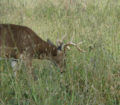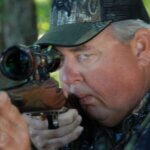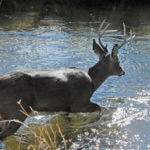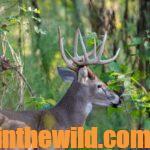Editor’s Note: Three elements cause deer to move – fear, sex and food. Once the hunter understands these three elements, he can predict deer movement more effectively and determine where and when a deer will show up. Fear usually plays a role in deer movement when hunter pressure is intense. Sex influences deer movement during the rut. However, every morning when a deer wakes up, he must decide what he’s eating for breakfast. Deer usually will eat something almost every day. Therefore, a food supply, as it relates to deer, may be the most-dependable ingredient for harvest success.
 When we look more closely at why I was able to bag three bucks under the same white oak tree (see Day 1), we have to understand why the deer continued to show up in this particular place. The white oak at the time I was hunting was a preferred food of the white-tailed deer. Deer will pick, nibble, eat and browse on almost everything in the forest, including all kinds of grasses, nuts and fruits. But like humans, some foods feel better in their mouths or taste better to them. The deer will take the choice parts of a plant maybe one month out of the year and ignore that plant the other 11 months.
When we look more closely at why I was able to bag three bucks under the same white oak tree (see Day 1), we have to understand why the deer continued to show up in this particular place. The white oak at the time I was hunting was a preferred food of the white-tailed deer. Deer will pick, nibble, eat and browse on almost everything in the forest, including all kinds of grasses, nuts and fruits. But like humans, some foods feel better in their mouths or taste better to them. The deer will take the choice parts of a plant maybe one month out of the year and ignore that plant the other 11 months.
In any given area, deer may have a half dozen foods they prefer over others. For instance, deer in my part of the country like oak seedlings and the ash group of trees better than they do hickory or pine seedlings. Also there are seasonal preferences for foods like muscadines, persimmons and other fruits that occur once a year.
The deer’s preferred foods are much like the dessert part of his meal. Many times the deer will walk a considerable distance to find that dessert. However, even when you know what the deer’s chosen food is during the time that you plan to hunt, you cannot be certain that you’ll concentrate the animals close enough to your stand to take a shot. To hunt over a preferred food source, that food has to be in short supply in the specific region where you are hunting. Then it will draw deer to it from the surrounding geographical region.
For instance, the white oak tree I hunted was the only one within about 1-1/2 miles. Most of the deer came to that tree to get the white oak acorns during the time the tree was dropping the acorns. When the acorns ceased to fall, the deer quit coming.
 Besides a deer’s preferred food changing throughout the year, the favorite food in one region for a certain group of deer may not be a favorite food in another area for another group of deer. One veteran hunter told me that on the western side of the state during the early fall, the deer prefer white oak acorns and turn their noses up at the red oaks, while on the other side of the state, the deer like the red oak acorns best. In many parts of the north, the deer’s preferred food during hunting season may be apples from an orchard. Yet in other sections of the country where apples are few, the deer may select sumac or soybeans instead.
Besides a deer’s preferred food changing throughout the year, the favorite food in one region for a certain group of deer may not be a favorite food in another area for another group of deer. One veteran hunter told me that on the western side of the state during the early fall, the deer prefer white oak acorns and turn their noses up at the red oaks, while on the other side of the state, the deer like the red oak acorns best. In many parts of the north, the deer’s preferred food during hunting season may be apples from an orchard. Yet in other sections of the country where apples are few, the deer may select sumac or soybeans instead.
To learn which foods you can concentrate deer around, contact your state’s game commission. Most states have a district biologist who is responsible for the game in each particular area. This wildlife specialist usually will know what the deer’s favorite food is during each week of hunting season. He also can tell you how to recognize the preferred food, and where you can find it. Hunters often waste thousands of hours scouting instead of contacting wildlife biologists in the area they plan to hunt before they enter the woods.
 Once a sportsman learns the deer’s preferred food, then he is ready to scout the woods and try to locate that food. When you find that preferred food, you should be able to tell from tracks, droppings and signs such as cracked acorn halves, nipped leaves or chewed branches, if the deer are utilizing that food source in the area you plan to hunt. Next, search for either a large concentration of that particular food source that will draw the deer into the food or an area that has very little of the deer’s preferred food.
Once a sportsman learns the deer’s preferred food, then he is ready to scout the woods and try to locate that food. When you find that preferred food, you should be able to tell from tracks, droppings and signs such as cracked acorn halves, nipped leaves or chewed branches, if the deer are utilizing that food source in the area you plan to hunt. Next, search for either a large concentration of that particular food source that will draw the deer into the food or an area that has very little of the deer’s preferred food.
Changes in nature also may change a deer’s preferred food. Droughts, floods and other natural calamities may interrupt the growth patterns of a specific food source and affect what the deer eat. Deer can determine the best and most-nutritious food available in a given area. If one year the soil type in a region is basically poor, and the browse it produces is also poor, deer will gravitate toward a well-fertilized green field that is producing better food than they can locate in the woods.
One season, the acorn crop failed on the lease where I hunted, which changed our traditional hunting pattern. Instead of hunting the acorn flats as we had for many years, the men I hunted with had to locate a different food source to hunt over. As we scouted the woods, we discovered that the pokeweed plant (see Day 1) had grown along many of the logging trails, especially the new ones. Where we found the pokeweed plant, we also located plenty of deer trails. Most of the pokeweed’s leaves were nipped off at the stems. As we continued to watch the stand of pokeweed, we found that whenever there was even a thumb-sized leaf coming out from the stems, the deer nipped these tender greens. On opening day, each of us located different logging roads with pokeweed on them where we took stands. All of us shot deer.
The deer’s feeding habits had changed because of the failing acorn crop. Even though the deer’s preferred food historically was acorns, if we had not scouted before the season, discovered that the acorn crop had failed and then located a new food source, our opening day hunt would have been a disaster.
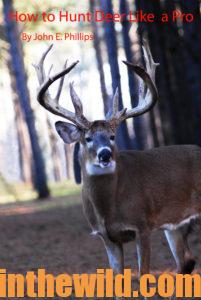
 To learn more about hunting deer, go to John E. Phillips’s book, “How to Hunt Deer Like a Pro” at https://www.amazon.com/How-Hunt-Deer-Like-Pro-ebook/dp/B007D3H08M, available in Kindle, print and Audible versions. To receive your free book on “How to Make Venison Jerky,” go to https://www.emailmeform.com/builder/form/Ece3UZVcOo52cKPJcL
To learn more about hunting deer, go to John E. Phillips’s book, “How to Hunt Deer Like a Pro” at https://www.amazon.com/How-Hunt-Deer-Like-Pro-ebook/dp/B007D3H08M, available in Kindle, print and Audible versions. To receive your free book on “How to Make Venison Jerky,” go to https://www.emailmeform.com/builder/form/Ece3UZVcOo52cKPJcL


